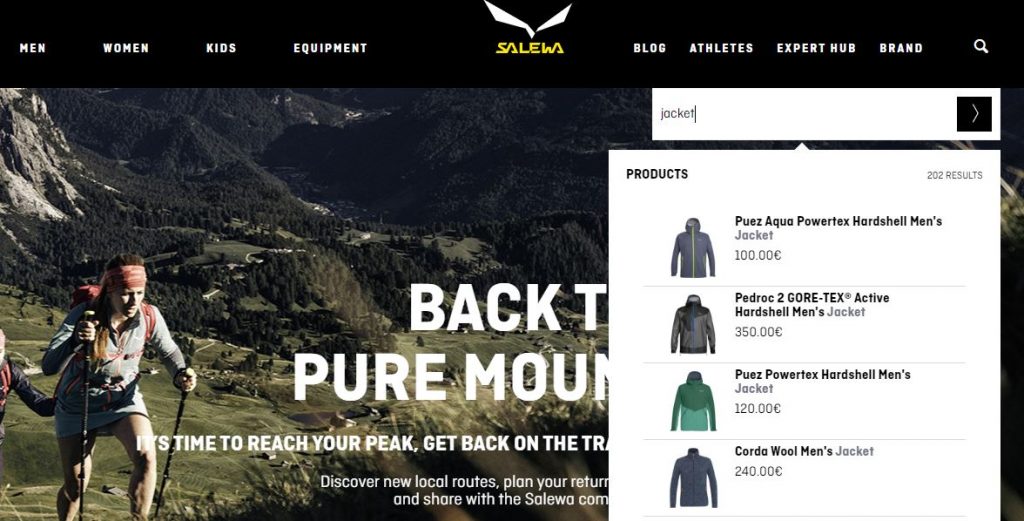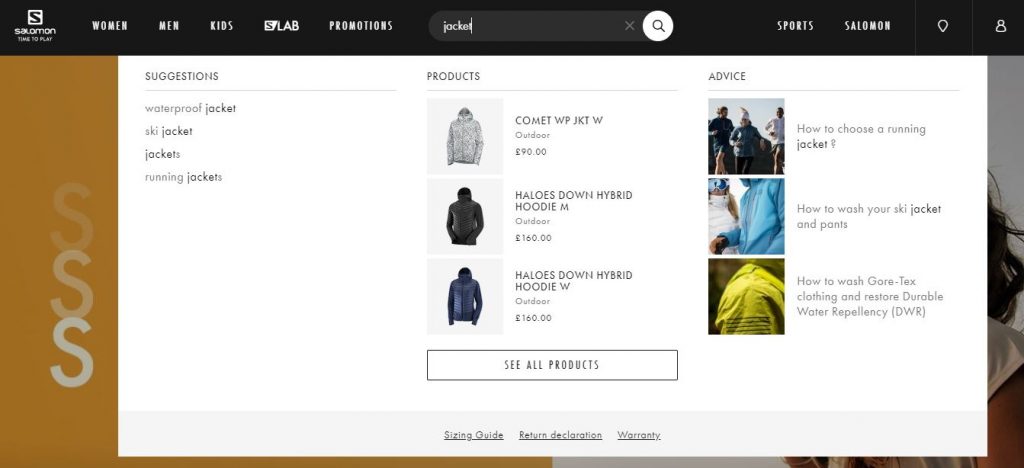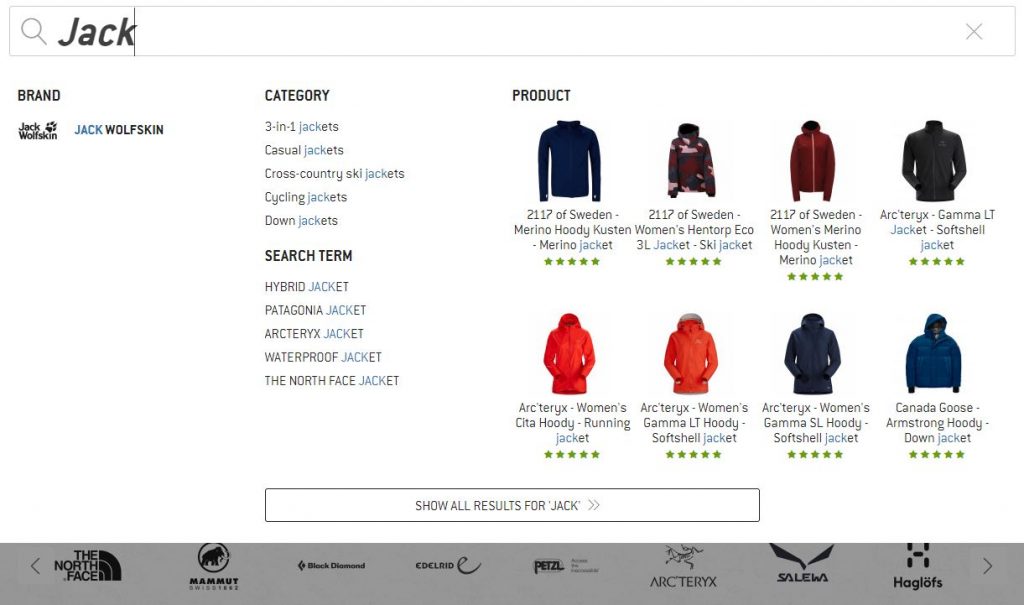The internal search changed rapidly with the evolution of the e-commerce platforms. The goal of this article is to point out some considerations about the data tracking of the usage of this feature.
What is the site search?
The site search it’s a typical feature available in most e-commerce websites. It’s also called “internal search”, “search widget”, “storefront search”, “store search” or with other similar names. The feature allows the users to search for specific products, SKUs, categories, or other information on the website. Usually, it’s recognizable by an icon of a magnifying glass 🔍. Consider a website like Salewa.com: in the search box a user can insert a generic product search like “jacket” or a specific product name as “Pedroc 2”.

Why this feature is critical for an e-commerce website? If a user is using the internal search could be due to different motivations:
- Speed of search: instead of the navigation menu someone maybe prefers to search quickly for a product category, especially on mobile.
- Specific search: to search a specific item by name or by SKU.
- Missing results: the menu is not well organized, the category page is not presenting the desired product or for other reasons.
Search terms data in the E-commerce platform
The e-commerce platform usually provides data about the interaction of the users with this feature. If you want to learn more about the common e-commerce platforms, please consider reading this article. Magento 2 provides a report named “Search Terms Report” (Menu: Reports > Search Terms). The report provides you with the data regarding the “Search Queries” that can be filtered by Store, the number of results provided, and the number of Hits. Below a generic example (not refereed to Salewa or to other brands in this article). What is missing? A time dimension to filter the results and refine the data analysis.

Similar to Magento, Shopify has a report called “Top online store searches” (Menu: Analytics > Reports > Behavior > Top online store searches). Shopify provides a Date Range picker to select a specific time period for the data analysis. Other e-commerce platforms have different reports for the features (as the “Storefront Search” for Salesforce B2C Commerce).
Great stuff. But are those platforms missing some data on the reports? The data provided refers to the “completed” searches with an input action by the user. This means that the website user needs to press “enter” on the keyboard or click on the icon of the search widget. See the example below on the mobile version on the Salewa website.

Search results suggestions and advanced search widgets
The internal search is changed from the past. The “standard” widget of the first e-commerce platform versions was a simple search box where a user can only input a text and press “enter”. In 2020 there is more to consider if a complete analysis needs to be presented. Consider the previous example: when the user searches for “Jacket” some products are shown in the search widget. Typical, these are suggested products to the search term, which might be the right answer for the user. These answers can be customized and improved, but this is another article (maybe the next?).
What if the user clicks on a suggestion? Is it Magento/Shopify and other platforms considering this clicks on their reporting? The answer is usually no.
Let’s consider some more advanced search widgets. In the example below, you can see the search outputs on the Salomon website. Three different kinds of results are provided: suggestions, products, and advice. Or consider a multi-brand store like Berge Freunde (Alpine Trek in it’s UK version). When the user starts typing “Jack…”: the search is incomplete and different suggestions appear like brand, category, search term, and product.


Solution: behavior data tracking and results analysis
So what’s next? Changing the way the e-commerce platform track the data is not easy (even if you’re a skilled developer). But you can use an external data analysis tool to track the complete usage of the internal search widget. The most common in 2020 is Google Analytics, but you can consider alternative solutions as Matomo.
Google Analytics allows you to track the search terms as the e-commerce platform already does. You can simply define the search parameter, usually “q” (e.g. https://www.salomon.com/en-gb/shop-emea/catalogsearch/result/?q=Jacket). Refers to this Google Article if haven’t implemented it before. But when you an advanced widget implemented? You can consider a custom tracking solution based on events to track the behavior data of the user interaction. The structure really depends on the Analytics specialist and on the Analytics Tool. Other solutions can also be considered as virtual pageviews with a “q” parameter. If you are a Digital Analytics specialist you can find more details on this article of Bounteous.
A possible solution in the example above (Salewa.com) can be the following, using the Google Analytics events feature. You can find some sample data at the following Google Sheet link. In this Google Datastudio Dashboard, a quick reporting for a possible starting data analysis based on the sample data.
Actions after reading
If you enjoyed reading this article there are some actions you can take now:
- Do you work for an e-commerce and you want to track better your internal search? Please send me a request on the contact page.
- Is it your marketing agency not providing you all the insight above? Let’s keep in touch, I can suggest a great new partner.
Side notes, credits, sources
- I haven’t worked or implemented a solution for the brands considered in this article. I was just looking for a winter Jacket for my outdoor activities 😂.
- Images sources: Salewa, Salomon, Alpine Trek.
- Articles: Bounteous.



